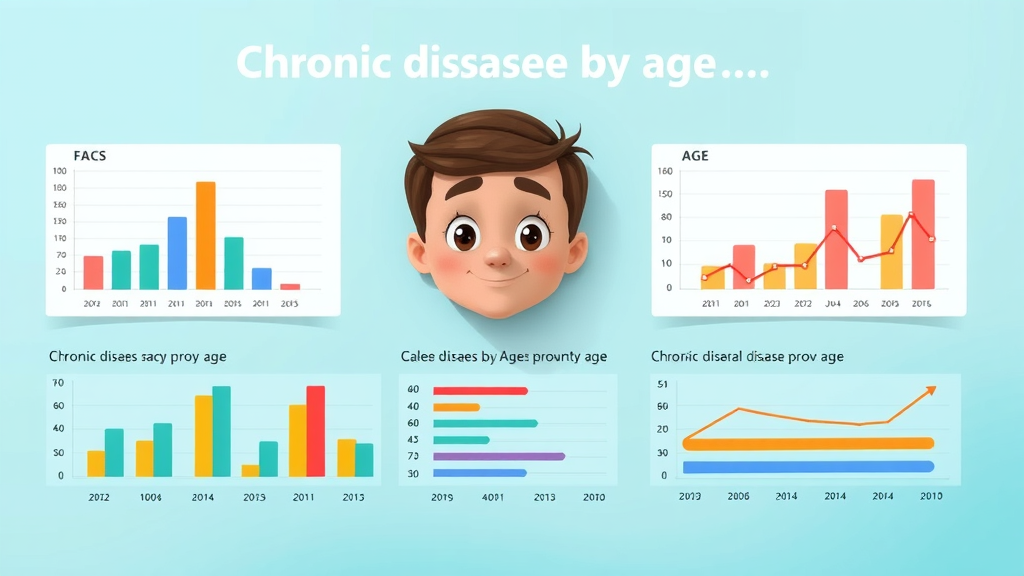Did you know that nearly 60% of adults in the United States are living with at least one chronic disease ? If you’re one of them, this guide is for you. Your chronic disease issues can be dramatically impacted in just 24 hours —not by miracle cures, but through actionable, science-backed changes. Whether you’re tackling high blood pressure, diabetes, or chronic respiratory problems, understanding and applying key steps—today—can jumpstart lasting benefits. Ready to unlock rapid improvements in your health—and learn why even a single day can make a dramatic difference? Dive in and see how you can reclaim control, starting now.
Startling Facts: The Hidden Impact of Chronic Disease Issues in the United States
Chronic disease issues infiltrate every aspect of American life, yet their toll is often underestimated. In the United States, chronic illness is the primary driver behind rising health care costs, decreased productivity, and diminished quality of life. Public health data reveals that more than half of American adults face at least one chronic condition , with millions struggling to control multiple illnesses at once. These numbers are more than statistics—they represent friends, family, and neighbors whose lives are shaped daily by the challenges of managing long-term health conditions.
The pervasiveness of chronic diseases such as heart disease, diabetes, and chronic respiratory problems not only increases individual suffering, but also creates ripple effects across the broader health system. Chronic conditions account for seven out of the top ten leading causes of death in the country, and contribute to nearly 90% of the nation’s $4.1 trillion in annual health care costs. The severity of this health crisis highlights the urgent need for clear action and better strategies to help those affected make noticeable improvements—starting today.

Chronic Disease Issues: A Growing Public Health Challenge Across America
- Discover how nearly 60% of adults in the United States live with at least one chronic condition.
Accelerate Your Path: Improving Chronic Disease Issues Fast
Facing chronic disease issues can feel overwhelming, but evidence shows that making rapid, intentional changes—even within 24 hours—can foster tangible results. The urgency is real: chronic conditions like hypertension and diabetes respond positively to prompt interventions, such as dietary shifts and increased physical activity. By choosing one or two targeted improvements today, you can lower inflammation, decrease blood sugar, and begin smoothing out destabilizing symptoms. Quick wins not only help the body recover faster, but also empower you to adopt longer-term habits for managing chronic dis and related health conditions.
Whether you’re managing high blood pressure, heart disease, or another chronic illness, starting with immediate action helps break inertia and boosts motivation. Monitoring blood pressure, eating a plant-rich meal, or going for a brisk walk provides not only physical benefits, but also a psychological boost—reminding you that improvement is possible at any stage. The sooner you start, the sooner your mind and body will notice the difference.
Why Address Chronic Disease Issues in 24 Hours Matters
- Immediate lifestyle changes and rapid interventions can yield measurable benefits for chronic disease management.
“Even small changes today can lay the groundwork for a healthier tomorrow.” – American Public Health Association

What You’ll Gain From Rapid Action on Chronic Disease Issues
- Science-backed strategies for reducing symptoms quickly
- Simple habits with high impact for chronic illness improvement
- How to assess and prioritize your personal chronic conditions
By embracing rapid changes, you’ll discover that chronic disease management doesn’t have to be slow or frustrating. Implementing the right steps can ease symptoms, increase energy, and set the stage for ongoing wellness. You’ll also learn practical techniques to identify which areas—be it poor nutrition, physical inactivity, or uncontrolled blood pressure—require immediate focus, helping you make the most effective progress in the shortest timeframe.
Building awareness of your particular chronic illness or condition is key. This guide will outline science-based actions and daily habits that can be started right away and produce genuine improvements, often within hours. Understanding how to prioritize self-care and monitor your results will give you confidence, clarity, and momentum on your chronic disease journey.
Understanding Chronic Disease Issues: Definitions and Prevalence
What Are Chronic Disease Issues and Chronic Conditions?
- Chronic conditions defined: ongoing health issues persisting for months or years
- Types: chronic dis, chronic disease, chronic illness, and their prevalence in society
Chronic disease issues refer to long-term medical conditions that affect a person’s health for months or years—often for a lifetime. These include a wide spectrum of chronic illnesses, from heart disease and diabetes to arthritis and chronic obstructive pulmonary disease. Unlike acute conditions, which resolve quickly, chronic conditions typically require ongoing care and can affect every aspect of daily living. Often, chronic diseases progress slowly, but they can dramatically reduce quality of life, limit mobility, and lead to secondary health problems if not properly managed.
The terms chronic illness , chronic condition , and chronic disease are frequently used interchangeably, though they may relate to different medical diagnoses. What unites them is their duration and the demand for continuous management. Prevalence continues to rise as populations age; chronic conditions are becoming more common, even among younger adults, due to evolving risk factors such as physical inactivity, excessive alcohol use, and poor nutrition.
Statistics: Prevalence of Chronic Disease in the United States
Data shows the prevalence of chronic disease rises sharply with age. For adults aged 45 and older, rates of heart disease, high blood pressure, and diabetes are particularly noteworthy. Analyzing prevalence by age group highlights the growing public health challenge—and the importance of early intervention across all demographics.
| Condition | Age 45-64 | 65+ |
|---|---|---|
| Heart Disease | 13% | 25% |
| High Blood Pressure | 38% | 55% |
| Diabetes | 15% | 26% |
| Chronic Respiratory Issues | 9% | 12% |

Top 10 Most Common Chronic Disease Issues Affecting Adults
- Heart Disease
- Stroke
- Diabetes
- Chronic respiratory diseases
- Cancer
- Chronic kidney disease
- Arthritis
- Alzheimer's disease
- High blood pressure
- Depression/mental health conditions
These ten chronic conditions account for the greatest burden on public health and individual well-being. Heart disease and high blood pressure remain the leading causes of hospitalization and death, while chronic diseases such as diabetes and cancer require lifelong monitoring. Mental health conditions , including depression and anxiety, also often overlap with physical health challenges, making simultaneous management essential. By recognizing which health conditions are most common, individuals and their support networks can better target prevention, self-monitoring, and early action for optimal results.

Root Causes: Major Risk Factors for Chronic Disease Issues
Understanding Risk Factors for Chronic Disease and Chronic Conditions
- Poor nutrition
- Physical inactivity
- Excessive alcohol consumption
- Tobacco use
- Genetic and environmental determinants
A combination of lifestyle choices, environmental exposures, and genetics contributes to the development of chronic disease issues. Poor nutrition —such as a high intake of processed foods or sugar—can drive metabolic issues that evolve into diabetes or heart disease. Similarly, physical inactivity reduces cardiovascular health and increases risk for obesity and related chronic illnesses. Excessive alcohol consumption and tobacco use are leading risk factors for multiple conditions including cancer, chronic respiratory disease, and chronic obstructive pulmonary disease.
While some risk factors, such as family history, are beyond our control, many others are modifiable. Building awareness of which habits need to change is the first step in combatting chronic dis and chronic conditions. By focusing on what you can adjust today—like diet and activity—you set the stage for rapid, meaningful progress.
How Social Determinants of Health Worsen Chronic Disease Issues
- Access to healthcare
- Socioeconomic status
- Environmental exposures
Social determinants of health —the environments in which people live, learn, work, and age—deeply affect their risk for chronic disease. Limited access to quality health care can delay diagnosis and management, while lower socioeconomic status may constrain the ability to access nutritious food or safe spaces for physical activity. Environmental exposures, such as pollution or lack of green space, further increase the burden of chronic conditions, especially in underserved communities.
Addressing these underlying factors is key to public health improvement and reducing disparities in chronic disease outcomes. Community-based initiatives and support from policy makers are essential, but individuals can also advocate for their own and their family’s health by identifying available resources and support networks—even when facing economic or social challenges.

Immediate Steps to Improve Chronic Disease Issues Within 24 Hours
Quick Nutrition Fixes for Chronic Disease Issues
- Swap refined carbs for whole grains
- Integrate more vegetables and fruits
- Reduce salt and sugar intake
Nutrition is one of the most impactful levers for instant change in chronic disease management. Within a single day, swapping out white bread or pastries for whole grains (like oatmeal or brown rice) can help stabilize blood sugar and reduce inflammation linked to chronic illness. Choosing colorful, fiber-rich vegetables and fruits at meals is another rapid fix that supports immune function and digestive health, both critical for long-term control of chronic dis.
Cutting back on added salt and sugar can produce almost immediate effects—lowering blood pressure and decreasing the risk of high blood sugar spikes, respectively. These simple “food swaps” don’t require a lot of planning and can be done with what’s already in your kitchen. Even incremental changes, like adding an extra serving of leafy greens to lunch or opting for fruit instead of a sugary snack, can make a measurable difference in how you feel by the end of the day.
Boost Physical Activity for Rapid Results in Chronic Conditions
- Take a brisk 20-minute walk
- Perform light stretching or chair exercises
- Incorporate movement in daily routines
A boost in physical activity doesn’t always require gym equipment or complicated routines. Studies show that taking a brisk 20-minute walk can improve circulation, reduce blood pressure, and naturally elevate mood. If mobility is a challenge, gentle stretching or chair-based exercises provide similar benefits and are vital for supporting joint health and preventing further physical inactivity linked to chronic disease issues.
Movement should be woven into the rhythm of your day—stand and stretch while watching TV, walk while talking on the phone, or perform a set of heel raises while cooking. Each of these micro-activities chips away at chronic illness symptoms and reinforces the kind of consistent, manageable activity that supports both mental health and body function.
Manage High Blood Pressure and Heart Disease Fast
- Monitor blood pressure at home
- Practice deep breathing and stress reduction
- Avoid excessive alcohol and caffeine
For those at risk of or currently managing heart disease or high blood pressure, daily monitoring is essential. Using a digital blood pressure cuff at home—ideally in the morning and evening—offers instant feedback and helps you catch early warning signs before they escalate. Pairing this with simple stress-reduction tools, like deep breathing exercises or guided meditation, helps regulate nervous system activity and counteracts the harmful effects of stress hormones on blood pressure.
Another urgent tweak for rapid improvement: moderate your intake of alcohol and caffeine. Both can spike blood pressure or interact with medications. Choose water or herbal tea instead, and be mindful of portion sizes if you do consume caffeinated or alcoholic drinks. With these rapid adjustments, you can often observe measurable improvements within hours—setting the stage for longer-term healing.

Mental Health and Chronic Disease Issues: The Overlap
Immediate Stress-Reduction Strategies for Chronic Illness
- Short mindfulness meditation
- Journaling or gratitude lists
- Social connection with friends or support groups
Mental health and chronic disease are intricately connected. Persistent stress, anxiety, or depression can worsen physical symptoms and make it harder to stick with self-care routines. Implementing a five-minute mindfulness meditation or deep breathing session at the start or end of your day can dramatically lower stress hormone levels and promote relaxation—even in the midst of challenging health conditions.
Keeping a gratitude journal or simply noting a few things that went well during the day can reframe negative thinking, restore hope, and encourage positive momentum. Social connection is equally important—even a quick phone call with a friend or attending a support group online can ease isolation and provide the encouragement needed to stick with healthy choices.

Control and Monitor: Simple At-Home Tracking for Chronic Disease Issues
Why Self-Monitoring Chronic Disease Issues Produces Results
- Tracking blood pressure, glucose, or symptoms increases self-awareness and prompts timely intervention
Self-monitoring is one of the most empowering steps for anyone managing chronic disease issues . By regularly tracking your blood pressure, blood glucose, or daily symptoms, you develop the insight needed to catch subtle changes before they become crises. Whether using pen and paper or a digital health tracker, documenting trends over time helps identify which interventions are working and where additional changes are necessary.
This real-time data supports you and your healthcare team in making personalized, precise adjustments—resulting in better outcomes and fewer complications. The act of self-monitoring also reinforces commitment; seeing small improvements, like a lower blood pressure reading or fewer fatigue days, strengthens habits and encourages you to keep moving forward.

Critical Habits: Building Your 24-Hour Chronic Condition Improvement Plan
- Prepare a balanced meal plan
- Set a short walk or gentle exercise goal
- Record health stats (blood pressure, glucose)
- Practice a 5-minute stress reduction activity
- Schedule tomorrow’s follow-up steps
Creating a simple, structured improvement plan for your own chronic condition begins with five actionable habits. First, outline nutritious meals using whole grains, lean proteins, and colorful vegetables. Next, aim for a short walk or other physical activity—even light stretching counts. Don’t forget to log at least one health statistic for accountability (like blood pressure or glucose).
Dedicate a few minutes for targeted stress reduction, whether that’s meditation, gentle yoga, or relaxed breathing. Finally, jot down at least one step you’ll follow up with tomorrow—consistency is crucial for ongoing improvement in chronic disease issues. This daily plan can be repeated and expanded as comfort and results grow.

Role of Support: How Family, Friends, and Healthcare Teams Can Help
Communication Tips for Chronic Illness, Chronic Disease Issues, and Mental Health
- Share goals and progress
- Seek encouragement for positive changes
Tackling chronic disease issues should never be a solo journey. Open communication with family, friends, and healthcare teams increases your chance of success. Sharing your daily goals and incremental progress fosters accountability and helps loved ones better support your efforts.
Don’t hesitate to ask for encouragement or practical help—whether it’s a walking partner, someone to help plan meals, or clarity on health care instructions. Support networks play a key role, especially in managing the mental health side of chronic illness. By engaging others, you’ll build connections that make sustainable change easier and more enjoyable.
Prevention Focus: How Acute Actions Support Long-Term Chronic Disease Management
- How daily choices accumulate for public health improvement
- Early intervention as disease prevention
Every healthy choice you make today contributes to more durable health benefits tomorrow. Acute actions—such as hydration, a balanced meal, or a single walk—compound over time, dramatically altering the trajectory of chronic conditions and contributing to greater public health.
Early intervention is the best form of disease prevention. By acting decisively at the earliest warning signs or by maintaining healthy habits before chronic symptoms worsen, you protect not only your own health but also reduce strain on the larger health care system. Rapid, daily efforts reinforce a culture of prevention, rather than crisis management.
| Step | Impact | Time Required |
|---|---|---|
| Drink more water | Hydration, energy | 5 min |
| Walk for 20 min | Circulation, mood | 20 min |
| Reduce salt in dinner | Blood pressure | 10 min |
People Also Ask: What are some chronic issues?
- Chronic issues include diabetes, high blood pressure, arthritis, asthma, cancer, heart disease, mental health disorders, and chronic respiratory conditions.
What are the 10 most common chronic conditions?
- The 10 most common chronic conditions are: heart disease, stroke, diabetes, chronic respiratory disease, cancer, chronic kidney disease, arthritis, Alzheimer’s disease, high blood pressure, and depression.
What are the effects of chronic disease on a person?
- Chronic disease can lead to persistent symptoms, reduced quality of life, financial stress, mental health challenges, and increased risk of secondary conditions.
What are the big 4 chronic diseases?
- The big 4 chronic diseases are heart disease, diabetes, cancer, and chronic respiratory disease.
Frequently Asked Questions About Chronic Disease Issues
-
Can I really improve chronic disease issues in just one day?
Yes. By making targeted changes to diet, movement, and stress levels, many people observe lower blood pressure, reduced blood sugar, or improved mood within hours. While not all effects are permanent after one day, these improvements often build momentum for continued progress. -
What small change has the highest impact?
Drinking more water, swapping to whole grains, or moving for just 20 minutes can each have an outsized impact on energy, inflammation, and chronic condition symptoms. Start with the area you find easiest for your lifestyle and expand from there. -
Does rapid change replace medical advice?
No. While rapid lifestyle adjustments can support chronic illness management, they should complement—not replace—your healthcare provider’s guidance and any prescribed treatments. -
How does mental health influence chronic disease?
Mental health conditions such as depression and anxiety can worsen physical symptoms, make chronic disease harder to manage, and increase the risk of complications. Addressing stress and seeking support boosts both physical and mental well-being.
Empowering Your Next Steps: Lasting Solutions for Chronic Disease Issues
“Your health tomorrow hinges on the choices you make today. Start small, keep going, and let progress build.”

Explore Further Resources on Chronic Disease Issues, Chronic Illness, and Wellness
- Explore CDC and WHO guidelines, support tools, and senior wellness communities for ongoing chronic disease management.
Take Action Now: Achieve Noticeable Change in Chronic Disease Issues Today
- For more great articles on Senior Health & Wellness, visit https://ElderEarth.us
Begin implementing one new habit right now, track your progress, and watch as improvement becomes your new normal—for chronic disease issues and for life.
Managing chronic disease issues effectively requires a comprehensive approach that includes understanding the emotional impact of chronic illnesses and implementing evidence-based self-management strategies.
The article “Living with a chronic illness - dealing with feelings” from MedlinePlus Medical Encyclopedia provides valuable insights into the emotional challenges individuals face when diagnosed with chronic conditions. It emphasizes the importance of acknowledging feelings such as anger, depression, and anxiety, and offers coping strategies to manage these emotions effectively. ( medlineplus.gov )
Additionally, the Centers for Disease Control and Prevention’s resource “Living with a Chronic Condition” outlines practical steps for managing chronic diseases. It highlights the significance of adhering to treatment plans, engaging in regular physical activity, and maintaining a healthy diet to improve quality of life and prevent complications. ( cdc.gov )
By exploring these resources, you can gain a deeper understanding of both the emotional and practical aspects of managing chronic disease issues, empowering you to take proactive steps toward better health.
 Add Element
Add Element  Add Row
Add Row 




Write A Comment